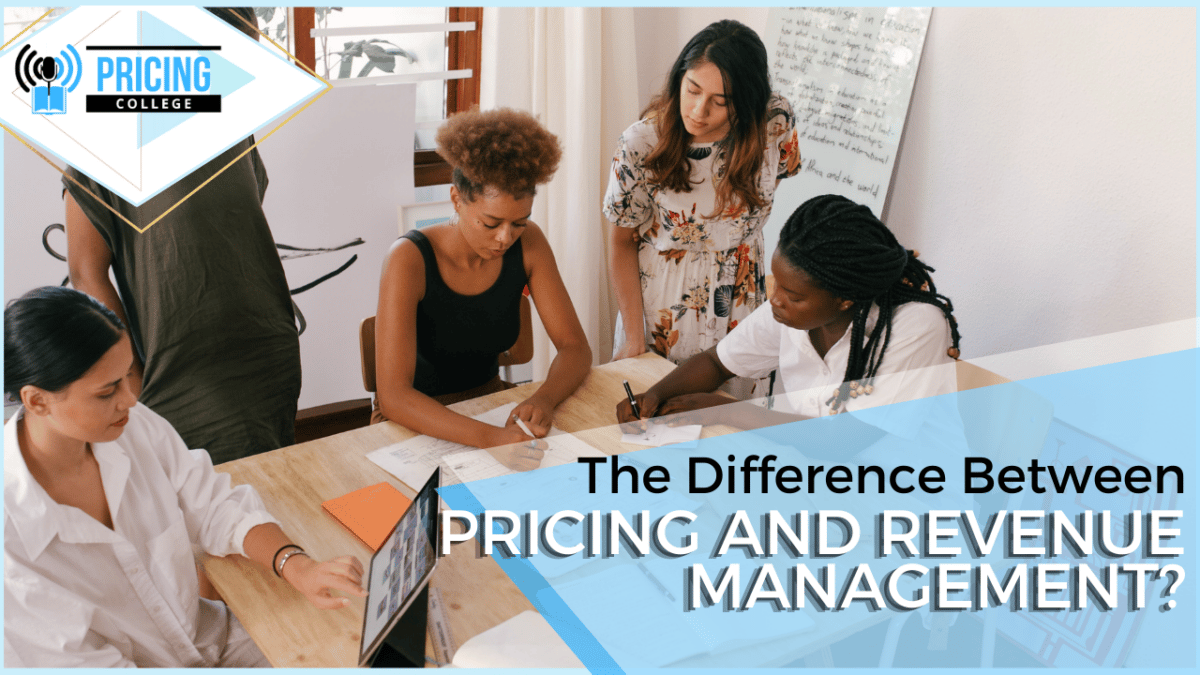
The Difference Between Pricing and Revenue Management 💹 Podcast Ep. 7
In this episode of Pricing College – Aidan and Joanna discuss the difference (if any) between pricing and revenue management. Is one a sub-sector of another or are they distinctly different?
Listen on Apple Podcasts Listen on Spotify Listen on Google Podcasts Listen on Stitcher Listen on Amazon Music
TIME-STAMPED SHOW NOTES:
[00:40] Joanna says revenue management is distinctly different.
[01:00] Aidan says there’s a trend for job advertisements under “revenue management.”
[01:35] Joanna says there can be a mistake made by people and the two are confused.
[02:00] Is revenue management a capacity-constrained area of pricing?
[02:30] Is revenue management moving more into forecasting.
[03:50] Joanna says revenue management is becoming more strategic.
[05:00] Revenue management really takes advantage of willingness to buy.
[05:30] Computer programs can be used to number crunch and consequently, really examine micro segments.
In today’s episode, we want to talk about, what is the difference between pricing and revenue management?
In broad terms, I would say price management concerns setting and managing prices to drive profitability for the business and your customers. Whereas, revenue management concerns allocating inventory to optimise your revenue.
You probably notice if you’re applying for a job in the pricing sector that revenue management, being honest, seems to be more jobs. In truth, there seems to be more jobs that describe this revenue management. That’s particularly in fields that are very much affected by covid bizarrely – such as airlines, hotels, rental cars, and cruise ships. Those sort of things.
This is because pricing is often misconstrued as revenue management. Nowadays, it’s considered more of the tactical lever as opposed to a strategic lever. People use pricing and revenue management interchangeably. This is because they want to drive volume or tactically discount in the market to push volume.
To my mind, in Layman’s terms, I think of revenue management as a sub-sector of pricing. If the entire sector is called pricing revenue management, to me, it applies to a certain sector which is capacity-constrained areas. Also, ideas such as hotels and airlines where you have a certain number of seats, rooms, or cars that you can rent out.
If demand goes through the roof overnight, you can’t increase a supply hugely. You’re trying to maximise revenue while assuming that your supply is constrained by physical capacity. On an airline, if flights are flying from New York to London tomorrow, there are 500 seats on that flight no matter what you do. And you can’t make more.
This is why revenue management is moving into more forecasting demand. So they can use that information to increase supply and know ahead of time that they need to produce more. In the instance of airlines, there are more flights.
Fundamentally, you could put on a very busy route you could put a different flight on. The way I look at the famous example as always the flight about to leave in one minute and there’s one seat left. What would it be profitable to sell that seat at? A famous example is a dollar or even one-cent as long as you’re not consuming excess fuel in the flight. And any extra money you bring in is profitable to the company.
Yeah, because you wouldn’t have sold it anyway. That’s right. Another example would be fuels and energy gas. They are traditionally known as businesses that use revenue management dynamic pricing. But that was more on the supply side. In fact, they’re using it to manage their supply, and how much they should produce and allocate to their distributors etc. But now they’re using it to think closely about forecasting, consumer demands, and what drives people to buy, so they can utilise revenue management to be more of a strategic lever.
When you think of revenue management. it’s almost as if you could think of it today as maximising revenue from what you have today.
We take an example again of an airline whereby people will accept the prices change based on criteria. Criteria such as time of day and red-eye flights are cheaper. They will accept that flying between two non-main airports might be cheaper. And flying over a weekend may be discounted if you do a longer stay. They will use methods to price discriminate between the potential customer. It makes sure they get every potential dollar revenue out of those customers that they can.
If there’s one seat for sale and you sell it to tourists who may or may not want to go to a certain city, versus the business person who has to get to that meeting on Monday at 9 am – the “willingness to pay” difference could be massive.
This comes down to customer value drivers and understanding why people are buying:
How are they buying?
Who are they buying from?
Are they coming through your website?
Are they coming through your call centre?
What’s the urgency they need to buy?
Looking at revenue management in recent years, a huge amount of technology, computer programs, and analytical data have been applied to that.
If you think, as Joanna mentioned, the number of potential value drivers for those customers is too much for any person to keep in their head. But, computer programs PROS is a famous example of the number crunch with thousands of potential and even more.
Yeah, they do that. But, they first look at segmentation to break this down. They break into what they call micro-segments which are fundamentally like different groups. You can allocate groups of customers and different groups of competitors. It’s breaking down the market so you can make it more manageable. Also, you can review the value drivers in a more systematic way. Then, you’ll find out that there’s a cross over between groups and other groups that are not.

LINKS MENTIONED IN TODAY’S EPISODE:
What is revenue management
PROS
Listen to a previous discussion about where pricing is set in 2020.
For a comprehensive view on building a great pricing team to prevent loss in revenue,
Download a complimentary whitepaper on How to Build Hiring Capability To Get The Best Pricing Team
Related Posts
Leave a Reply Cancel reply
Categories
- marketing strategy (26)
- Organisational Design (14)
- Podcast (114)
- Pricing Capability (87)
- Pricing Career Advice (10)
- Pricing Recruitment (19)
- Pricing Strategy (287)
- Pricing Team Skills (13)
- Pricing Teams & Culture (24)
- Pricing Transformation (47)
- Revenue Model (25)
- Sales Effectiveness (27)
- Talent Management (7)
- Technical Pricing Skills (35)





